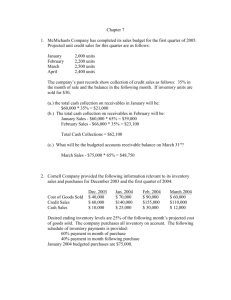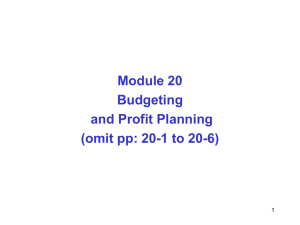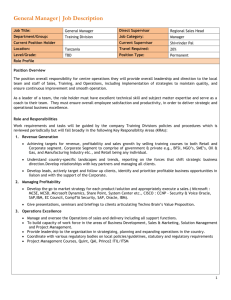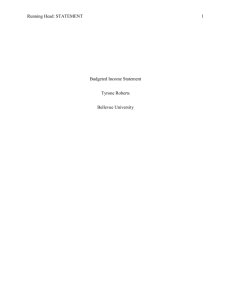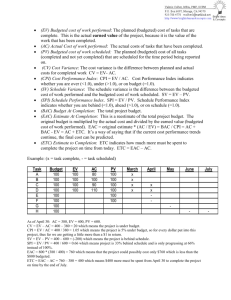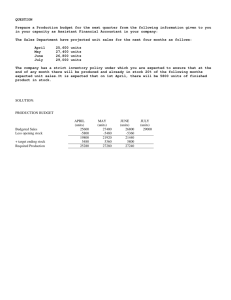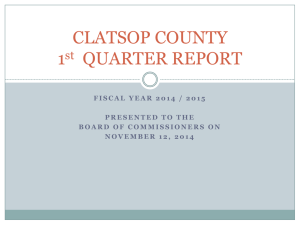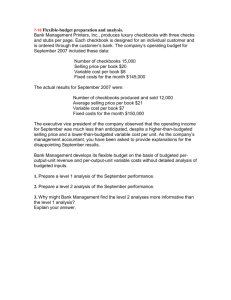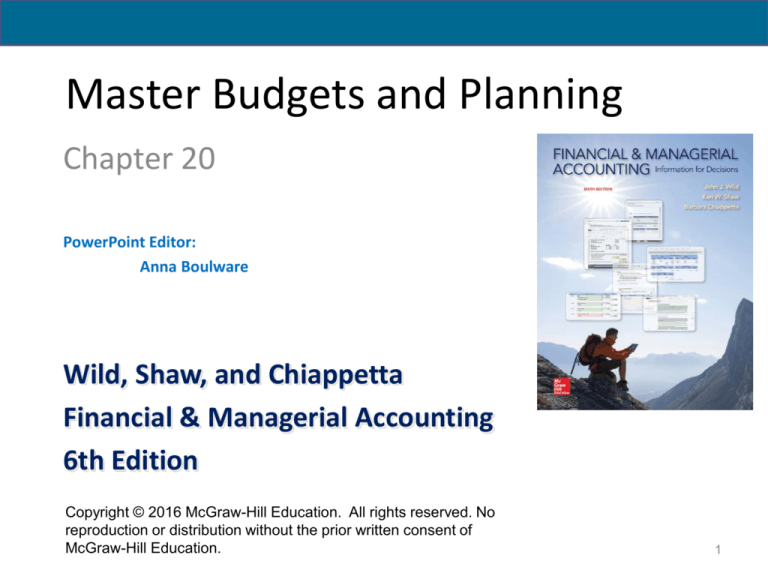
Master Budgets and Planning
Chapter 20
PowerPoint Editor:
Anna Boulware
Wild, Shaw, and Chiappetta
Financial & Managerial Accounting
6th Edition
Copyright © 2016 McGraw-Hill Education. All rights reserved. No
reproduction or distribution without the prior written consent of
McGraw-Hill Education.
1
20-C1: Budget Process
and Administration
2
Enhances coordination so that
activities of all units contribute to
meeting the company’s overall goals.
Provides a benchmark
for evaluating
performance.
Promotes analysis
and a focus on
the future.
Benefits of
Budgeting
Converts long-term
Communicates
strategic plans into
management plans
short-term financial
throughout the
plans.
organization.
Motivates employees through
participation in the budgeting process
and the establishment of attainable goals.
C1
3
Budget Reporting and Timing
Annual Budget
2015
2016
2017
2018
The annual budget
may be divided into quarterly
or monthly budgets.
A continuous or rolling budget is a
twelve-month
budget that rolls forward one month
as the
current month is completed.
C1
4
Budget Committee
Top Management
Middle
Management
Supervisor
Supervisor
Middle
Management
Supervisor
Supervisor
Flow of budget data is a bottom-up process.
C1
5
Budget Committee
The budget committee is responsible for budgeting
policies and for coordinating the efforts of all participants
in the budgeting process.
Consists of managers from
all departments of the
organization.
Provides central guidance to
insure that individual
budgets submitted from all
departments are realistic
and coordinated.
C1
6
20-C2: Master Budget
Components
7
Master Budget Process for a
Manufacturer
C2
8
20-P1: Operating Budgets
9
Sales Budget
The first step in preparing the master budget is the sales budget,
which shows the planned sales units and the expected dollars from
these sales.
Sales
Budget
Estimated
Unit Sales
Estimated
Unit Price
Analysis of economic and market conditions
+
Forecasts of customer needs from marketing personnel
P1
10
Sales Budget
Example: In September 2015, Toronto Sticks
Company sold 700 hockey sticks at $60 each.
Toronto Sticks prepared the following sales
budget for the next three months:
P1
11
Sales Budget
Example: TSC sold 700 hockey sticks at $60 per unit. After
considering sales predictions and market conditions, TSC
prepares its sales budget for the next three months.
P1
12
Production Budget
A manufacturer prepares a production budget, which shows
the number of units to be produced in a period.
The production budget is based on the unit sales
projected in the sales budget, along with inventory
considerations.
Note: A production budget does not show costs; it is always
expressed in units of product.
P1
13
Production Budget
The production budget is based on the unit sales projected in
the sales budget, along with inventory considerations.
P1
14
NEED-TO-KNOW 20-1
A manufacturing company predicts sales of 220 units for May and 250 units for June. The company wants
each month’s ending inventory to equal 30% of next month’s predicted unit sales. Beginning inventory for
May is 66 units.
Compute the company’s budgeted production in units for May.
Budgeted ending inventory for May
Plus: Budgeted sales for May
Required units of available production
Less: Beginning inventory (units)
Total units to be produced
P1
75 30% of 250 (June’s expected sales)
220
295
(66)
229
15
Direct Materials Budget
The direct materials budget shows the budgeted costs for
the direct materials that will need to be purchased to satisfy
the estimated production for the period
P1
16
Direct Labor Budget
The direct labor budget shows the budgeted costs for the
direct labor that will be needed to satisfy the estimated
production for the period.
P1
17
NEED-TO-KNOW 20-2
A manufacturing company budgets production of 800 units during June and 900 units during July. Each
unit of finished goods requires 2 pounds of direct materials, at a cost of $8 per pound. The company maintains
an inventory of direct materials equal to 10% of next month’s budgeted production. Beginning direct
materials inventory for June is 160 pounds. Each finished unit requires 1 hour of direct labor at the rate of
$14 per hour.
Compute the budgeted (a) cost of direct materials purchases for June and (b) direct labor cost for June.
P1
Budgeted production (units)
Materials requirements per unit (lbs.)
Materials needed for production (lbs.)
Add: Budgeted ending inventory (lbs.)
Total materials requirements (lbs.)
Less: Beginning inventory (lbs.)
Materials to be purchased (lbs.)
Material price per pound
Total cost of direct materials purchases
800
2
1,600
180 (July production of 900 units x 2 lbs. per unit x 10%)
1,780
(160)
1,620
$8
$12,960
Budgeted production (units)
Labor requirements per unit (hrs.)
Total direct labor hours needed
Labor rate (per hour)
Total cost of direct labor
800
1
800
$14
$11,200
18
Factory Overhead Budget
The factory overhead budget shows the budgeted costs
for factory overhead that will be needed to complete the
estimated production for the period.
P1
The variable portion of factory overhead is assigned at the
rate of $2.50 per unit of production. The fixed overhead is
$1,500 per month.
19
Product Cost Per Unit
With the information from the three manufacturing
budgets (direct materials, direct labor, and factory
overhead), we can compute TSC’s product cost per unit.
For budgeting purposes, TSC assumes it will normally produce
3,000 units of product each quarter, yielding fixed overhead of
$1.50 per unit. TSC’s other product costs are all variable.
P1
20
Selling Expense Budget
The selling expense budget is an estimate of the
types and amounts of selling expenses expected
during the budget period.
TSC pays sales
commissions equal to 10
percent of total sales.
TSC pays a monthly salary
of $2,000 to its sales
manager.
Let’s prepare the selling expense budget for
Toronto Sticks Company.
P1
21
Selling Expense Budget
From TSC’s sales budget
TSC pays sales commissions equal to 10 percent of total sales.
TSC pays a monthly salary of $2,000 to its sales manager.
P1
22
General and Administrative
Expense Budget
The general and administrative expense budget plans
the predicted operating expenses not included in the
selling expenses or manufacturing budgets.
Toronto Sticks Company has
general and administrative
salaries of $54,000 per year
or $4,500 per month.
Let’s prepare the general and administrative
expense budget for TSC.
P1
23
General and Administrative
Expense Budget
Toronto Sticks Company has general and
administrative salaries of $54,000 per year or
$4,500 per month.
P1
24
NEED-TO-KNOW 20-3
A manufacturing company budgets sales of $70,000 during July. It pays sales commissions of 5% of sales
and also pays a sales manager a salary of $3,000 per month. Other monthly costs include depreciation on
office equipment ($500), insurance expense ($200), advertising ($1,000), and office manager salary of
$2,500 per month. For the month of July, compute the total (a) budgeted selling expense and (b) budgeted
general and administrative expense.
P1
Budgeted selling expense
Sales commissions
($70,000 x 5%)
Sales manager's salary
Advertising expense
Total budgeted selling expense
Total
$3,500
3,000
1,000
$7,500
Budgeted general and administrative expense
Depreciation on office equipment
Insurance expense
Office manager's salary
Total budgeted and administrative expense
Total
$500
200
2,500
$3,200
25
Capital Expenditures Budget
The capital expenditures budget shows dollar amounts
estimated to be spent to purchase additional plant assets the
company will use to carry out its budgeted business
activities.
TSC does not anticipate disposal of any
plant assets through December 2015, but
management is planning to acquire
additional equipment for $25,000 cash in
December 2015.
*Since this is the only budgeted
capital expenditure for the quarter,
no separate budget is shown.
P1
It also shows any
amounts expected
to be received
from plant asset
disposals, as
companies replace
old assets with
new ones.
26
20-P2: Cash Budget
27
Cash Budgets
After developing budgets for sales, manufacturing costs,
expenses, and capital expenditures, the next step is to
prepare the cash budget, which shows expected cash
inflows and outflows during the budget period.
The general formula for a cash budget is:
The cash budget is especially important because it helps
the company maintain a cash balance necessary to meet
ongoing obligations.
P2
28
Budgeted Cash Receipts (from Sales)
40% of TSC’s sales are
for cash.
The remaining 60% are
credit sales that are
collected in full in the
month following the sale.
Let’s prepare the cash receipts budget for TSC.
P2
29
Budgeted Cash Receipts from Sales
From TSC’ sales budget
P2
Cash sales are 40%
of each month’s sales
Accounts receivable balance at the end of each month
is 60% of that month’s budgeted sales.
30
Cash Payments for Materials
Managers use the beginning balance sheet and the direct materials
budget prepared earlier, to help prepare a schedule of cash
disbursements for materials.
TSC’s purchases of
materials are entirely on
account.
Full payment is made in the
month following the
purchase.
Let’s look at the schedule of cash payments
for materials for TSC.
P2
31
Cash Payments for Direct Materials
From direct materials budget
P2
TSC’s purchases of materials
are entirely on account.
Full payment is made in the
month following the purchase.
32
Preparing the Cash Budget
Beginning
Cash
Balance
+
Budgeted
Cash Receipts
–
Budgeted
Cash
Disbursements
=
Preliminary
Cash
Balance
If adequate, repay loans or buy securities.
If inadequate, increase short-term loans.
Additional information for TSC’s cash budget:
– Has a September 30 cash balance of $20,000.
Continue
– Will pay a cash dividend of $3,000 in November.
P2
33
Cash Budget
Toronto Sticks Company:
– Has an income tax liability of $20,000 from the previous quarter
that will be paid in October.
– Will purchase $25,000 of equipment in December.
– Has an agreement with its bank for loans at the end of each
month to enable a minimum cash balance of $20,000.
– Pays interest each month equal to one percent of the prior
month’s ending loan balance.
– Repays loans when the ending cash balance exceeds $20,000.
– Owes $10,000 on this loan arrangement on September 30.
– Has 40 percent income tax rate.
– Will pay taxes for current quarter next year.
P2
34
From Cash Receipts Budget
TSC’s cash balance at the beginning of October is $20,000.
Budgeted cash receipts for October are $49,200, resulting
in a total of $69,200 available for the month.
Now we are ready to look at TSC’s cash disbursements
P2
35
Income taxes of $20,000 were due
as of the end of September 30,
2015, and payable in October.
P2
We next subtract expected cash
payments for direct materials,
direct labor, overhead, selling
expenses, and general and
administrative expenses.
36
TSC has a $10,000 loan and pays
interest at the rate of one percent per
month. October’s interest is $100.
P2
TSC has a
dividend payment
of $3,000 that it
plans to pay in
November.
37
TSC has an agreement with its bank for loans at
the end of each month to provide a minimum
cash balance of $20,000. If the cash balance
exceeds $20,000 at a month-end, as it does
here, TSC uses the excess to repay loans.
P2
38
Ending cash balance for
October
is the beginning November
balance.
P2
TSC interest on it’s outstanding loan amount in
November is $44.
39
One last item, before our cash
budget is complete…TSC plans
to pay $25,000 in December to
purchase new equipment.
P2
40
20-P3: Budgeted Financial
Statements
41
Budgeted Income Statement
The budgeted income statement is a managerial
accounting report showing predicted amounts
of sales and expenses for the budget period.
Cash
Budget
Budgeted
Income
Statement
Let’s prepare the budgeted income
statement for Toronto Sticks Company.
P3
42
Budgeted Income Statement
All information in this budgeted income
statement is taken from the component
budgets we’ve examined on previous
slides.
P3
The predicted amount of income tax
expense for the quarter, computed as
40% of the budgeted pretax income,
is included.
43
Budgeted Balance Sheet
The budgeted balance sheet shows predicted amounts
for the company’s assets, liabilities, and
equity as of the end of the budget period.
Budgeted
Income
Statement
Budgeted
Balance
Sheet
Let’s prepare the budgeted balance
sheet for Toronto Sticks Company.
P3
44
Budgeted Balance Sheet
The budgeted balance sheet for TSC is prepared using
information from the other budgets.
P3
45
Global View
Royal Phillips Electronics of the Netherlands is a diversified
company. Preparing budgets and evaluating progress helps the
company achieve its goals. In a recent annual report, the
company reports that it budgets sales to grow at a faster pace
than overall economic growth. Based on this sales target,
company managers prepare detailed operating, capital
expenditures, and financial budgets.
Budgeted and actual results of companies that do business
globally are impacted by changes in foreign currency exchange
rates as well as global and political uncertainties. Forecasting in
that environment is difficult.
46
20-A1: Activity-Based
Budgeting
47
Activity-Based Budgeting
Activity-based budgeting is based on activities rather
than traditional items such as salaries, supplies,
depreciation, and utilities.
Accounting Department
Comparison of Activity-Based Budget with Traditional Budget
A1
An understanding of the resources required to perform the activities, the
costs associated with these resources, and the way resource use changes
with changes in activity levels allows management to better assess how
expenses will change to accommodate changes in activity levels.
48
20A-P4 (Appendix):
Merchandise Purchases Budget
49
Merchandise Purchases Budget
Unlike a manufacturing company, a merchandiser
must prepare a merchandise purchases budget
rather than a production budget.
P4
Example: Let’s look at the merchandise purchases budget for
Hockey Den (HD), a retailer of hockey sticks…
50
Merchandise Purchases Budget
Example: Hockey Den buys hockey sticks for $60 each
and maintains an ending inventory equal to 90 percent of
the next month’s budgeted sales. On September 30,
1,010 hockey sticks are on hand.
The general layout for the purchases budget in
equation form is:
Let’s prepare the purchases budget for Hockey Den.
P4
51
Merchandise Purchases Budget
From the sales budget.
Ending inventory for a month in units,
should equal 90% of next month’s unit
sales.
P4
Next we add the
unit sales for each
month to the
desired ending
inventory to get
the total needs for
each month. 52
52
Merchandise Purchases Budget
Required units of
available merchandise.
P4
Subtract beginning inventory to
determine the budgeted number of
units to be purchased.
Budgeted cost of the purchases,
computed by:
number of units X cost per unit.
53
NEED-TO-KNOW 20-4
In preparing monthly budgets for the third quarter, a company budgeted sales of 120 units for July and 140
units for August. Management wants each month’s ending inventory to be 60% of next month’s sales. The
June 30 inventory consists of 50 units, which does not comply with the company's inventory policy. How
many units should be purchased in July?
Next month's budgeted sales (units)
Ratio of inventory to future sales
Budgeted ending inventory (units)
Add: Budgeted sales (units)
Required units of available merchandise
Deduct: Beginning inventory (units)
Units to be purchased
P4
140
60%
84
120
204
(72)
132
54
End of Chapter 20
55

